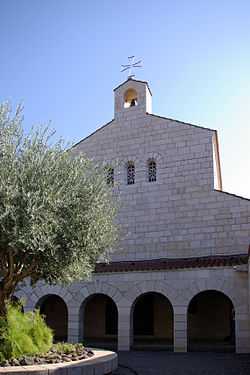Tabgha



Tabgha (Arabic: الطابغة, al-Tabigha; Hebrew: עין שבע, Ein Sheva) is an area situated on the north-western shore of the Sea of Galilee in Israel. It is the traditional site of the miracle of the multiplication of the loaves and fishes (Mark 6:30-46) and the fourth resurrection appearance of Jesus (John 21:1-24) in Christianity. Until 1948, it was the site of an Arab village.
The site's name is derived from the Greek name Heptapegon ("seven springs"). St. Jerome referred to Tabgha as "the solitude" (=eremos).
In 1596, Al-Tabigha formed part of the Ottoman Empire, a village in the nahiya (subdistrict) of Jira under the liwa' ("district") of Safad, with a population of 44. It paid taxes on a number of crops, including wheat and barley, as well as on goats, beehives and orchards.[1]
At the time of the 1931 census, al-Tabigha had 53 occupied houses and a population of 223 Muslims, 21 Christians, and 1 Jew.[2]
On May 4, 1948, just before the outbreak of the Arab-Israeli war, Tabgha was attacked by Palmah forces, supported by the Alexandroni Brigades and local Hagana units. Its Arab inhabitants were expelled and their houses and tents were destroyed under orders by Yigal Allon.[3]
Church of the Multiplication
The earliest building at Tabgha was a small chapel built in the 4th century A.D. This was probably the shrine described by the pilgrim Egeria at the end of the 4th century:

In the same place (not far from Capernaum) facing the Sea of Galilee is a well watered land in which lush grasses grow, with numerous trees and palms. Nearby are seven springs which provide abundant water. In this fruitful garden Jesus fed five thousand people with five loaves of bread and two fish.—[4]
The mosaic of the fish and loaves is laid next to a large rock, which has caused some New Testament scholars to speculate that the builders of the original church believed that Jesus stood on this rock when he blessed the fish and loaves just before the feeding of the crowd who had come to hear him.

The large monastery and a church were built in the fifth century. While some date the destruction of the site to the time of the Arab conquest, the church was most likely destroyed in 614 during the Persian invasion, for already in AD 670, Bishop Arculf had reported that only columns from the church remained.
In 1932, after nearly 1300 years of "solitude", two German archaeologists (Mader and Schneider) uncovered a number of the Byzantine church's walls and mosaics.
In 1981, after further excavations, the church was finally restored by German Benedictines to its Byzantine form, incorporating portions of the original mosaics.
Today, the church and surrounding land are property of the German Association of the Holy Land whose head is the Archbishop of Cologne. The site is further maintained by Benedictine monks from the Hagia Maria Sion Abbey, also known as Dormition Church, which is located on Mount Zion in Jerusalem.
Church of the Primacy of St. Peter

The Church of the Primacy of St. Peter, north of the Church of the Multiplication, was built on rocks at the shore of the Sea of Galilee, traditionally considered to be the place where Jesus appeared the fourth time after his resurrection (John 21:1-24), during which, according to Catholic teaching, Jesus again conferred primacy on Simon Peter.
Shrimp
The Critically Endangered, troglobitic, blind shrimp Typhlocaris galilea is endemic to the Roman Ein-Nur octagonal pool, and a subterranean spring that feeds it, at Tabgha,[5][6]
References
- ↑ Hütteroth, Wolf-Dieter and Kamal Abdulfattah (1977), Historical Geography of Palestine, Transjordan and Southern Syria in the Late 16th Century. Erlanger Geographische Arbeiten, Sonderband 5. Erlangen, Germany: Vorstand der Fränkischen Geographischen Gesellschaft. p. 176. Quoted in Khalidi (1992), p. 542.
- ↑ E. Mills, ed. (1932). Census of Palestine 1931. Population of Villages, Towns and Administrative Areas. Jerusalem: Government of Palestine. p. 85.
- ↑ Morris, 2004, pp. xvii, 250.
- ↑ The Miracle Church at Tabgha on the Sea of Galilee, Bargil Pixner, Biblical Archaeologist, Vol. 48, No. 4 (Dec., 1985) , pp. 196-206
- ↑ Tsurnamal, M. "Temperature Preference of the Blind Prawn, Typhlocaris galilea Calman (Decapoda, Caridea)". Crustaceana 34 (3). Retrieved 2013-05-06.
- ↑ Kloosterman, Karin (2013-05-06). "Blind Shrimp Spared from Extinction at Bible Zoo in Jerusalem". Green Prophet. Retrieved 6 May 2013.
| Wikimedia Commons has media related to Tabgha. |
Coordinates: 32°52′25.17″N 35°32′56.31″E / 32.8736583°N 35.5489750°E